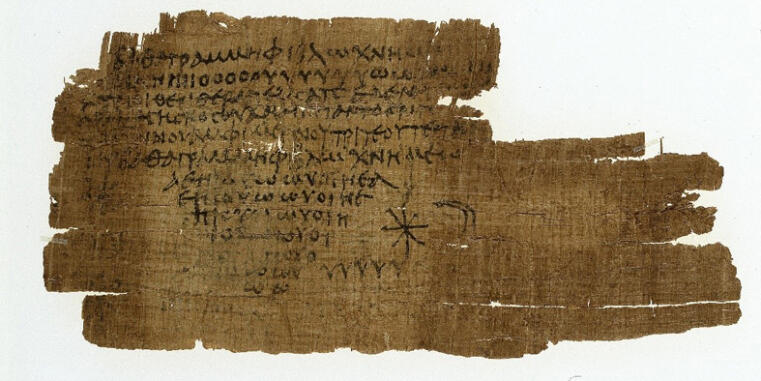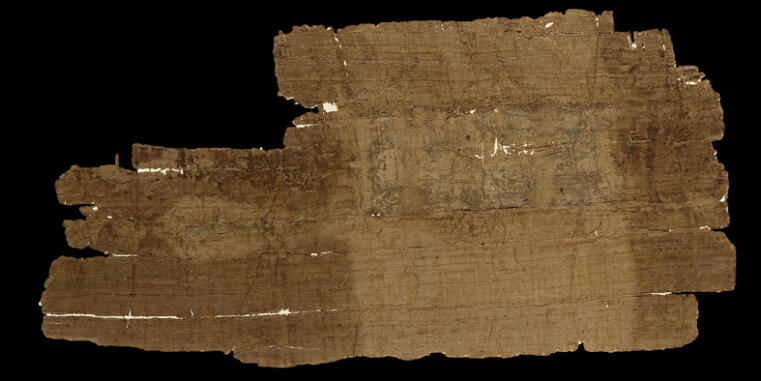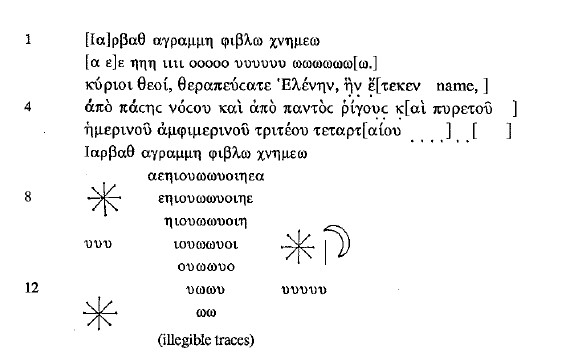No masks, but magic – magic papyri as protection against sickness
By historian Matthias Sandberg
The current, sometimes emotionalized, debate on the pros and cons of wearing masks as a protective measure against the unrestricted spread of Covid-19 touches on the issue of the value of solidarity and actions of solidarity within society. Values, norms and rules of collective coexistence in the time of the pandemic, such as punishment for non-compliance with the AHA formula, are sometimes interpreted as unacceptable reprisals and as an unjustified attack on individual liberties by the authorities. The insight that protecting oneself and protecting others are linked reciprocally does not seem to have reached everyone.
The Athenian historian Thucydides, who wrote about the plague in Athens (430-426 BC), already observed that acting in solidarity in the face of an invisible threat is not an automatic feature of society as a whole, that it is not always easy to differentiate between individual and collective needs, and that it can be painful:
But the greatest misery of all was the dejection of mind in such as found themselves beginning to be sick (for they grew presently desperate and gave themselves over without making any resistance), as also their dying thus like sheep, infected by mutual visitation, for the greatest mortality proceeded that way. For if men forebore to visit them for fear, then they died forlorn; whereby many families became empty for want of such as should take care of them. If they forbore not, then they died themselves, and principally the honestest men. For out of shame they would not spare themselves but went in unto their friends, especially after it was come to this pass that even their domestics, wearied with the lamentations of them that died and overcome with the greatness of the calamity, were no longer moved therewith.
The question arises as to whether there was also strong opposition to the wearing of masks among the Athens polis. But there was no reason for such opposition: although Hippocratic medicine identified the cause of various illnesses as being the evil vapours (the μίασμα) emerging from the ground and their air-borne transmission, we cannot prove that the Old World insisted on the wearing of masks to prevent infection. The ancient societies used other measures, which can also be explained by the fact that antiquity always attributed transcendent qualities to the symptoms of disease and epidemics. Thus, besides isolating the sick in the event of an epidemic, the most important thing was to ensure individual well-being through divine assistance. Medical and magical practices were therefore often interwoven: protective spells for the individual and invocations to the gods can be found in amulets, which were attributed an apotropaic (i.e. evil-averting) effect. Their wearers expected magical protection, and the distraction of evil spirits (δαίμονες) or of the ‘evil eye’, which were often deemed the cause of illness and suffering.
Medical-magical amulets were either worn prophylactically to protect the person against the general threat of illnesses or evil spirits, but could also be used ‘therapeutically’ against a specific ailment, such as digestive problems and fever. Since the amulets often contained a text consisting of magical formulas and appeals for divine help, they were made of different materials that could be written on, such as papyrus or metal lamellae, which were rolled and bound, or worn in small metal tubes directly against the body – for example, around the neck, or on the arm or hip. Since simpler amulets could easily be made by the wearer herself, they enjoyed great popularity throughout antiquity and in numerous cultures. It is due to Egypt’s climate, which is conducive to the conservation of papyri, that numerous remnants of these individual protective measures against diseases and epidemics have come down to us, such as the following:



This 14-line Greek text from a fever amulet from the 3rd century AD that was found in Egypt reveals a number of typical features that magical practices and medical-magical amulets had: besides the astral references in the form of stars and the crescent moon, magical powers are attributed above all to the arrangement of the text in the form of an isosceles triangle. Lines 1-2 contain various magical formulae and presumably the names of certain Egyptian deities deemed to have healing powers. Lines 3-5 contain an invocation to the gods: “Gods, heal Helene, who has been ... born, of every illness, every chill, and every fever”. The repetition and careful listing of all possible evils corresponds to the ancient belief that ‘contractual’ protection occurs if the magic formulae and invocations to the gods are strictly observed. The request is framed by an enumeration of vowels in the dwindling scheme. This enumeration can be explained by the idea, attested to in many magical papyri, that such a diminution of the name of an evil spirit or illness breaks or even dissolves its power.
The fact that magical practices and the power of amulets to protect people against illness continued into Christian antiquity is attested to, among many other examples, by the following text from the 5th/6th century AD, a time when Egypt belonged to the Christian Eastern Roman Empire; a narrow papyrus strip, probably rolled up, reports the following:
... Virgin Mary, and was crucified by Pontius Pilate, and was buried in the tomb, and rose again on the third day, and was lifted up to heaven, and ... Because You [Jesus] healed every ailment and every illness of man, … Jesus, ... believe ... because at that time You entered the house of Peter’s mother-in-law, who was feverish and the fever was gone; so I ask You, heal now, Jesus, Your servant, who bears Your holy name, of every sickness and every fever, of chills, of headaches and of every witchcraft and of every evil spirit, in the name of the Father and of the Son and of the Holy Ghost. (Translated from M.W. Meyer)

We do not know the name of the woman, but we do know that she called on Jesus for divine help, and that she asked for protection from fever, sickness, witchcraft and evil spirits; the text concludes with the Trisagion, praise of the Trinity. The combination of popular Christian piety and magical practices is revealed not only in the reference to the New Testament tradition of the story of suffering and the miracles of Christ, and the appeal to Jesus as a healing deity, but also in the fact that, like the magical formulae of the first example, the Trinitarian formula is deemed to ensure the amulet’s efficacy.
Medical-magical amulets were regarded throughout the ancient world as a proven means of arming oneself against the imponderables of human existence. And the underlying belief in the power of invocation and supplication in the form of ‘magical texts’ can also be observed today. In traditional Jewish households, for example, Mesusot, ritualistically produced and specially written parchments in writing capsules, are attached to door frames of certain rooms as a blessing. Adopting an ancient-historical perspective on the phenomenon of the need for protection against illness and suffering as an anthropological constant of human existence, and investigating magical practices and apotropaic amulets in the Old World, we can shed a different light on the current debate about everyday and individual protective measures against the imponderables caused by the epidemic.

